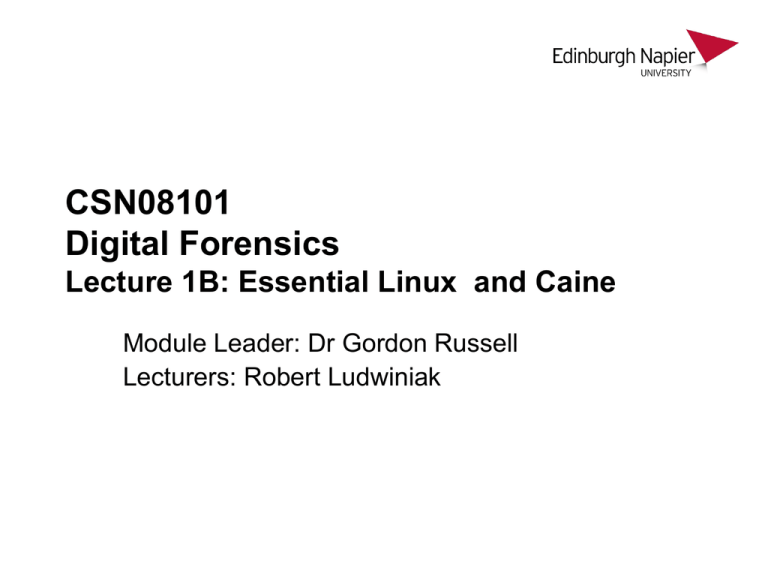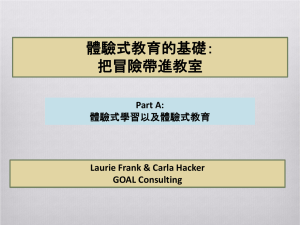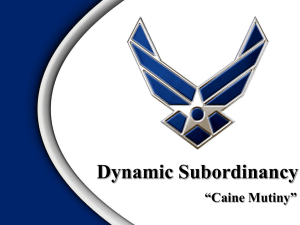PPT - Dr Gordon Russell
advertisement

CSN08101 Digital Forensics Lecture 1B: Essential Linux and Caine Module Leader: Dr Gordon Russell Lecturers: Robert Ludwiniak Essential Linux and Caine You will learn in this lecture: • Essential Command Line Linux • Basics of the GUI and Caine environment. Running the Virtual Machines • Visit http://linuxzoo.net/ • Change the drop-down in the control box to “Register for an account” • Read the instructions and click the link at the bottom. • You must provide your email address, name, matriculation number, and correctly select your programme. • Get the AUTH CODE from the lab tutor. User Registration Red means it went wrong. If you are still on this page when you click “Register” then it went wrong. Check Your Account (FULL) means your auth code worked. (GUEST) means you need “Your Profile” then reenter the auth code. Without the code you may get less system time and a poor queue position. • This is the control panel. • You MUST ALWAYS have at least 1 window open in linuxzoo. • If you navigate all windows away from linuxzoo you will be logged out. Queue for a machine • Once logged in Join the Queue. • During busy period you may have to wait in the queue for a while... Boot the machine • HALT is the same as OFF. You need to switch the machine on. • Make sure you choose “Linux Fedora 15”. Booting takes time Connect to your machine • You can have Java Telnet and JavaScript Telnet from here. • But better to have a real telnet or ssh client. • You can download an excellent ssh client from the web called putty. http://www.chiark.greenend.org.uk/~sgtatham/putty/download.html then download putty.exe Putty in the JKCC • It is “SSH Putty”. Putty login • Hostname is “linuxzoo.net”. • Then click Open • Administration username is “root” and password is “secure”. • When created the demo account is password “demo”. Why A Command Prompt? • Linux does have a graphical interface. • However it is faster, easier, and more powerful to use commands at a prompt to configure a server. • Commands do mean a steep learning curve. • Editing is tough! • You can have a graphical interface by clicking on “Java VNC” in the connect tab of the control panel. – You need Java installed! – Sometimes when you release a key that event is lost. This causes the last key pressed to repeat infinitely. Just press another key to fix the problem. The VNC of Fedora 15 The Tutorials. Tutorials Username • The Caine environment has a user called “caine” with password “caine”. • If you need to run a “root” administration command you need to use “sudo”. This is explained in the practicals. Running a tutorial Machine • • • • • • Your machine is a VIRTUAL machine. Your VM uses a shared computer resource. The resource is limited! Do not go crazy (do not recompile the world). Priority goes to those in timetabled labs. Your virtual disk is not reliably preserved between sessions. Do not save your life work on it. The Basics • Before your machine operates it must BOOT. • As it boots things are started up. • Only when the boot process completes will the system be fully operational. • When you are finished, a machine can be shutdown or halted. – Shutdown – does it nicely and cleanly – HALT – pulls the power out the back. Connecting to Caine • VNC gives you the graphical desktop. – Good in general but hard to cut-and-paste between the virtual machine and your own machine – CTRL C may cause a strange key repeat problem. – Needs Java Applets and support for HTTP CONNECT. • telnet is old-fashioned but is often installed in older Oses. – No graphic support but low bandwidth. – Easy cut and paste. – Needs TCP port 23. • Ssh is new-world. – No graphic support but low bandwidth – Very easy cut and paste – Needs TCP port 22. • Best to use a mix of interfaces to get the best overall experience. Basic Commands • To see the files and directories in a directory use the “ls” command. • Sometimes pronounced “list”. • Examples: $ ls Desktop dir1 f1 my1 thedir thefile $ ls -a . .. .bash_history .cache .config .dbus Desktop dir1 .dmrc .esd_auth .evolution f1 .fontconfig .gconf .gconfd .gksu.lock .gnome2 .gnome2_private .gvfs .ICEauthority .icons .local my1 .nautilus .pulse .pulse-cookie .recently-used.xbel .sudo_as_admin_successful thedir thefile .themes .thumbnails .update-notifier .xsession-errors .xsession-errors.old Long listing $ ls -l total 16 drwsrwsrwt drwxr-xr-x -rw-r--r-drwxr-xr-x drwxr-xr-x -rw-r--r-- 2 2 1 2 2 1 caine caine caine caine caine caine caine caine caine caine caine caine 4096 4096 0 4096 4096 0 2012-01-10 2012-01-19 2012-01-19 2012-01-19 2012-01-19 2012-01-19 Owner of the data Size of the data “d” for directory, “-” for file 13:21 11:29 11:29 11:29 11:29 11:29 Desktop dir1 f1 my1 thedir thefile Directory Traversal: cd and pwd $ pwd /home/caine $ cd .. $ pwd /home $ cd /home/caine $ pwd /home/caine $ cd dir1 $ pwd /home/caine/dir1 Directory Creation $ pwd /home/caine $ mkdir newdir $ ls –l drwxr-xr-x 2 caine caine 4096 2012-01-19 11:29 my1 drwxr-xr-x 2 caine caine 4096 2012-01-19 12:37 newdir -rw-r--r-- 1 caine caine 0 2012-01-19 11:29 thefile $ cd newdir $ pwd /home/caine/newdir $ cd .. $ pwd /home/caine Directory Removal $ pwd /home/caine $ rmdir newdir rmdir: failed to remove `newdir': Directory not empty $ ls newdir d2 $ rm –rf newdir • “r” is recursive and “f” is force. • Use care, as this can delete everything from the top to the bottom of a directory tree without prompting “are you sure”! cd .. • If you are in a directory and you want to go to the parent, use “..” $ pwd /home/caine $ cd .. $ pwd /home cd ../.. • You can navigate multiple steps in one go using “/” $ pwd /home/caine/dir1 $ cd .. $ pwd /home $ cd caine/dir1 $ pwd /home/caine/dir1 $ cd ../../caine $ pwd /home/caine Assessment: Short-Answer Examples • Specify the commands to create the following directory tree in /home/caine /home/caine dir1 dir4 dir5 dir2 dir3 $ cd /home/caine $ mkdir dir1 $ mkdir dir2 $ mkdir dir3 $ mkdir dir1/dir4 $ mkdir dir1/dir4/dir5 $ cd /home/caine $ mkdir dir1 $ mkdir dir2 $ mkdir dir3 $ cd dir1 $ mkdir dir4 $ cd dir4 $ mkdir dir5 $ cd /home/caine $ mkdir dir1 dir2 dir3 $ mkdir dir1/dir4 $ mkdir dir1/dir4/dir5 What is the biggest file? drwsrwsrwt drwxr-xr-x -rw-r--r-drwxr-xr-x drwxr-xr-x -rw-r--r-- 2 2 1 2 2 1 caine caine caine caine caine caine caine caine caine caine caine caine 4096 4096 4095 4096 4096 50 2012-01-10 2012-01-19 2012-01-19 2012-01-19 2012-01-19 2012-01-19 13:21 11:29 11:29 11:29 11:29 11:29 Desktop thing3 thing2 my1 thedir thefile








